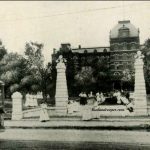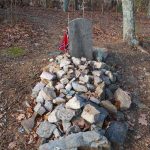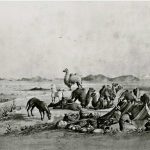
I love dirt roads, and Georgia is full of them.
When I was 18 and a newbie on the college campus of my father’s choosing, I was a member of The Dirt Road Club.
The requirements were simple – you had to have enough money to invest in either gas or an appropriate beverage or two for you and your fellow club members, you had to be willing to devote an occasional Saturday or Sunday to what could end up being an all day and all night road trip, and IF you were the official driver for said trip you had to be willing to turn off the main highway each an every time you came upon a dirt road and follow it until you couldn’t follow it any longer. Needless to say, I’m quite the expert when it comes to what might be private drives and logging roads all over North Georgia.
Just like the explorers of the 1500s, and just like those folks who brave the elements to climb Mt. Everest, the members of The Dirt Road Club ventured forth because they were compelled to follow the red dirt. Our club motto was “Because it’s there!”
Yes, there were some dirt roads that were a bit scary, some that had that “Deliverance” feel to them, and some were just plain dangerous. Others were pure gems.
Once when riding along through forest the trees suddenly cleared and we found ourselves on a ridge where you could see mountain rise after mountain rise in the distance. Another time we found a mountain stream complete with waterfall and on the hills rising up all around us were hundred of mountain laurel in full bloom.
Those were the moments that kept us going down all those dirt roads.
The road seen in my image at the beginning of this post has distinction of being the longest and oldest dirt road still in use in America. It’s also located in my home state of Georgia!
The road is located on Ossabaw Island, a barrier island along Georgia’s coast. The island contains over 26,000 acres and archeologists have determined humans have lived on or have used the island in some way for the past 4,000 years.
Though it had two other prior owners, Ossabaw Island was owned by John Morel during Georgia’s colonial years and through the American Revolution. He purchased half of the island in 1760 and the other half in 1763. Morel was a Savannah merchant and Council of Safety member who, with the help of slave labor, used the island for timber cutting and agriculture.
Indigo, cotton, and rice were the main cash crops cultivated on Ossabaw.
During Morel’s ownership the avenue of oaks that remain today were planted along the long dirt road that traverses the island. To make it easier to manage agricultural operations on the island, Morel divided the land into tracts.
Following Morel’s death in 1777, the tracts were divided among his sons. Bryan Morel received North End Place, Peter Henry received Middle Place, and John Morel II took control of South End.
I am assuming they shared ownership of the fourth tract known as Buckhead. After the War of 1812, the highly sought Sea Island cotton was raised on Ossabaw. Sea Island cotton had stronger filaments than cotton grown on the mainland, and it was very desirable by textile manufacturers.
During the Civil War Southern ports endured a Union blockade. Since the Morel family couldn’t ship their cotton, they abandoned Ossabaw Island. During Reconstruction a Freedman’s Bureau office set up shop on the island to help the former slaves of the Morel family. In fact, the Ossabaw Foundation site states that many of the former slaves from Ossabaw eventually relocated to Pin Point, Georgia which is the home of Supreme Court Justice Clarence Thomas.
The remains of three slave cabins can be found at the northern end of the island. One is thought to date from 1820 and the other two date from the 1840s. Archeologists have found alligator teeth and raccoon bones in the area surrounding the cabins along with the makings of a mojo bag and blue beads. It was thought that the color blue would ward off any spirits. It was believed that spirits didn’t like the color blue because it reminded them of heaven.
During the Gilded Age in the late 1800s the island was controlled by the Wannamaker family of Philadelphia. They used Ossabaw as a hunting club. During the 1920s, Dr. H.N. Torrey built a vacation home – a home that is actually a mansion. The Torrey family had moved to Savannah from Grosse Pointe, Michigan in 1923, and when their Savannah home burned, Ossabaw became their home. It has been reported that Henry Ford, who had his own Georgia plantation, was the first to sign the Torrey’s guestbook.
Eventually, the island passed to the Torrey’s daughter, Eleanor Torrey West. Along with her husband, Clifford West, the Ossabaw Foundation was created which launched many unique programs on the island, such as the Ossabaw Island Project. This interdisciplinary program supported recommended individuals “of creative thought and purpose in the arts, sciences, industry, education, and religion” to come to the island to share their ideas with other creative types and pursue their work without interruption.
The island was turned over to the state of Georgia in 1978, and was designated as Georgia’s first Heritage Preserve with the written understanding that Ossabaw would “only be used for natural, scientific, and cultural study, research and education, and environmentally sound preservation, conservation, and management of the island’s ecosystem.”
The acquisition was made possible by the generosity of Mrs. West and her family, a personal gift to the state of Georgia from Robert W. Woodruff (Coca-Cola), the assistance of The Nature Conservancy, and the State’s commitment to the preservation of the island.
Gee, just think….all of that and a dirt road to boot.
Thanks, Mrs. West!
For further reading: This Smithsonian article also details slave life on the island, and more information can be found HERE and HERE.




Enjoyed.